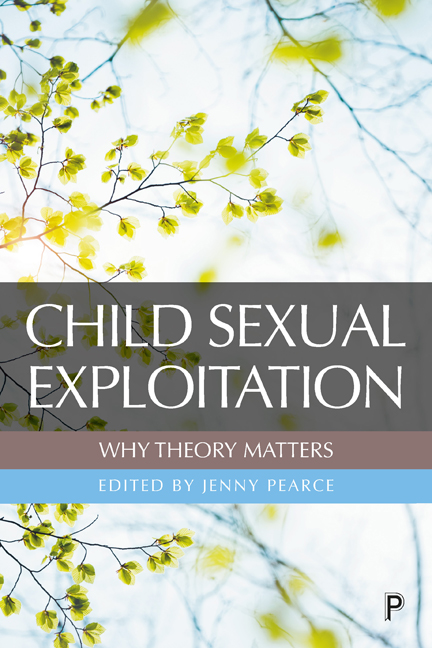Book contents
- Frontmatter
- Contents
- List of Figures and Tables
- Notes on Contributors
- Editor’s Acknowledgements
- Foreword
- 1 Bringing Theory Home: Thinking About Child Sexual Exploitation
- 2 Moving Beyond Discourses of Agency, Gain and Blame: Reconceptualising Young People’S Experiences of Sexual Exploitation
- 3 Child Sexual Exploitation, Discourse Analysis and why we Still Need to Talk About Prostitution
- 4 Contextual Safeguarding: Theorising the Contexts of Child Protection and Peer Abuse
- 5 ‘Losing Track of Morality’: Understanding Online Forces and Dynamics Conducive to Child Sexual Exploitation
- 6 Understanding Adolescent Development in the Context of Child Sexual Exploitation
- 7 Some Psychodynamic Understandings of Child Sexual Exploitation
- 8 Understanding Trauma and its Relevance to Child Sexual Exploitation
- 9 Social Support, Empathy and Ecology: A Theoretical Underpinning for Working with Young People who have Suffered Child Sexual Abuse or Exploitation
- 10 Using an Intersectional Lens to Examine the Child Sexual Exploitation of Black Adolescents
- 11 What’s Gender Got to do With It? Sexual Exploitation of Children as Patriarchal Violence
- 12 Understanding Models of Disability to Improve Responses to Children with Learning Disabilities
- 13 Some Concluding Thoughts
- Index
7 - Some Psychodynamic Understandings of Child Sexual Exploitation
Published online by Cambridge University Press: 10 March 2021
- Frontmatter
- Contents
- List of Figures and Tables
- Notes on Contributors
- Editor’s Acknowledgements
- Foreword
- 1 Bringing Theory Home: Thinking About Child Sexual Exploitation
- 2 Moving Beyond Discourses of Agency, Gain and Blame: Reconceptualising Young People’S Experiences of Sexual Exploitation
- 3 Child Sexual Exploitation, Discourse Analysis and why we Still Need to Talk About Prostitution
- 4 Contextual Safeguarding: Theorising the Contexts of Child Protection and Peer Abuse
- 5 ‘Losing Track of Morality’: Understanding Online Forces and Dynamics Conducive to Child Sexual Exploitation
- 6 Understanding Adolescent Development in the Context of Child Sexual Exploitation
- 7 Some Psychodynamic Understandings of Child Sexual Exploitation
- 8 Understanding Trauma and its Relevance to Child Sexual Exploitation
- 9 Social Support, Empathy and Ecology: A Theoretical Underpinning for Working with Young People who have Suffered Child Sexual Abuse or Exploitation
- 10 Using an Intersectional Lens to Examine the Child Sexual Exploitation of Black Adolescents
- 11 What’s Gender Got to do With It? Sexual Exploitation of Children as Patriarchal Violence
- 12 Understanding Models of Disability to Improve Responses to Children with Learning Disabilities
- 13 Some Concluding Thoughts
- Index
Summary
This chapter tries to understand child sexual exploitation (CSE) through the lens of psychodynamic theory. As babies and as children growing up, how do we develop a sense of who and how we’re supposed to be? How do the potentially loving, creative, assertive parts of ourselves get distorted and damaged? How do our earliest relationships affect the anxieties driving our subsequent behaviours? How do we defend ourselves against powerlessness and shame? Why do perpetrators and victims often find themselves stuck in certain roles? How might we understand hatred and guilt, aggression and sexuality in relation to CSE? In short, how does CSE become the focus of intra-psychic and inter-personal dynamics?
Trying to understand these things doesn't excuse the perpetrators, nor does it suggest that the victims are culpable. It doesn't assume that victims can't also be perpetrators or perpetrators victims. It's just that, until we understand, it's hard to know how to respond to CSE and how to prevent further exploitation. Can children and young people (CYP) be active and passive participants in their own exploitation? Are they pressed into lives of misery or do they undertake these lives with some degree of choice? Pearce (2009) describes the complexity of these questions for legislators as well as for those trying to intervene and help. The answers aren't simple because CYP aren't simple. Developmentally, they’re forever exploring their own sense of agency, the extent to which they control the world or are controlled by it. And their sense of sexual agency is no less important than any other kind of agency.
Few of us change our behaviours until the causes of our behaviours have been understood. Of course, it's easy to distance ourselves from CSE by simply blaming other people. We might try to blame CYP for their misfortune, men for the many cruelties they inflict and mothers for absolutely everything! But blaming other people tries to simplify what isn't simple and suggests that the rest of us are somehow off the hook.
CSE is everyone's concern, everyone's responsibility
A developing sense of self
There are environmental factors that might predispose someone to becoming vulnerable to CSE either as a perpetrator or victim (poverty, lack of educational opportunity, unemployment, family circumstances), but what of the psychodynamic factors? What goes on in someone's head and how is that ‘head’, that sense of self created in the first place?
- Type
- Chapter
- Information
- Child Sexual Exploitation: Why Theory Matters , pp. 133 - 150Publisher: Bristol University PressPrint publication year: 2019



